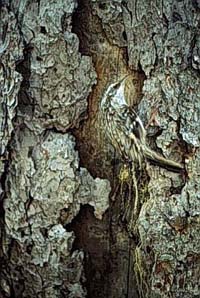Source-sink dynamics of boreal forest songbirds
 |
The shift towards communities dominated by generalist or non-native species has raised a number of concerns. In particular, have these changes altered the suitability of remnant habitat for native species to the point that they are demographic sinks instead of population sources? Demographic information for boreal forest songbirds is limited and the effects of industrial development on source-sink status are poorly understood despite the need for such information in environmental decision-making. Energy sector development has the potential to reduce the quality of remaining forested habitat for forest birds in a multitude of ways but mostly centers around edge effects: 1) increasing rates of nest failure due to higher rates of nest predation and/or brood parasitism; 2) changing food supply that reduces the ability of parents to adequately provision young; and 3) reducing juvenile survival due to increased mortality after fledging due to higher predation risk and/or poorer body condition.
In 2005, Bayne and several students initiated a large-scale mensurative experiment in conjunction with Environment Canada, Alberta Conservation Association, the Canadian Energy Pipeline Association, and the ILM Chair to examine how linear feature dissection at various spatial scales influences the demography of forest birds. Most research on edge effects has been done at the patch level comparing edge vs. interior. As demonstrated by our work on community shifts, changes in predator-prey relationships may be more likely to occur at very large landscape scales. We have taken a unique approach in this experiment of comparing linear edges to forest interiors at both local and landscape levels. Replicate 5km by 5km landscapes in northwestern Alberta have been stratified into: 1) low linear density, far from agricultural development; 2) low linear feature density, close to agricultural development; 3) high linear feature density, far from agricultural development; and 4) high linear feature density, near agricultural development. Within each landscape nested subplots that are directly adjacent to pipeline edges versus the forest interior (> 300 m from any linear edge) are monitored. This design allows us to tease apart the relative importance of landscape level changes in human activity versus local edge effects.
At each subplot, information on density of forest songbirds, nest success of forest songbirds, relative abundance & behaviour of predators, and specific habitat attributes are collected. Small predators are surveyed directly at nest monitoring points (i.e. small rodents via live-trapping and red squirrels via acoustic survey). A pilot study by MSc candidate, Amy Darling, indicates a significant change in the abundance and composition of small mammals along pipelines and wellpads. This shift in small mammals could directly influence songbird productivity if they are important songbird predators. Small mammal shifts could also result in increased incidental predation on songbirds if larger predators (i.e. coyotes and raptors) spend more time near human disturbances due to the higher abundance and availability of small mammal prey. Predators with larger home ranges such as raptors, corvids, and cowbirds are surveyed using audio playbacks to elicit acoustic responses along transects set throughout each landscape. Gray jays are fitted with radio-transmitters to monitor their movements along linear features. Recent work with video cameras at songbird nests (see below) suggests raptors (i.e. sharp-shinned hawks) may be an underestimated source of predation on songbirds. If this result is borne out, movement behaviour of raptors along linear feature edges will also be examined using telemetry. Scent stations in combination with wire hair snares and automatic cameras are used to assess the abundance of other predators such as mustelids, bears, and coyotes during the summer months to supplement the data collected in other projects.
Jeff Ball is using an advanced video recording system capable of monitoring 50 nests per year to assess which predators actually destroy nests. This will allow us to understand the relative importance of native predators versus species like the coyote and cowbird. This system also allows us to link changes in parental foraging behavior and insect food supply to predation risk. While nest predation has been hypothesized as the key factor limiting forest songbird populations, there is virtually no data on the survival of juvenile forest songbirds post-fledging. We will test the hypothesis that fledgling birds raised near edges leave the nest in poorer condition and subsequently suffer higher mortality. Using a small tail-mounted transmitter we will follow the fate of juvenile thrushes for a period of a month once they leave the nest. We will then use advanced survival analysis techniques to assess how parental effort in varying conditions influences post-fledging survival.